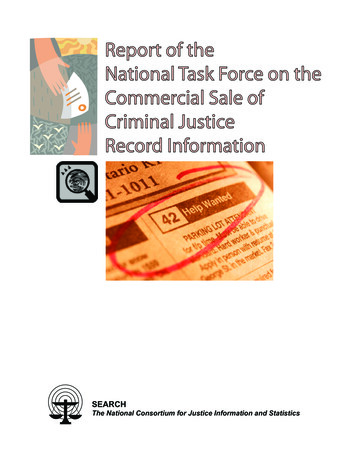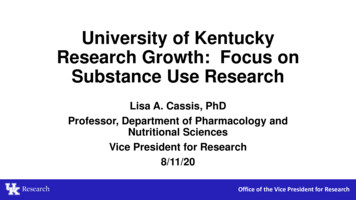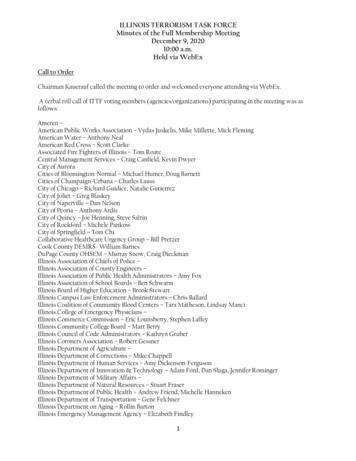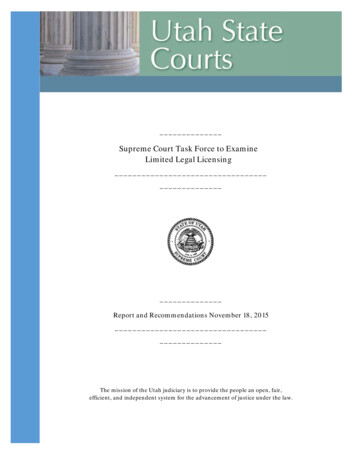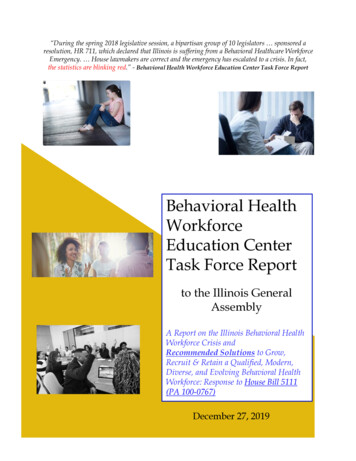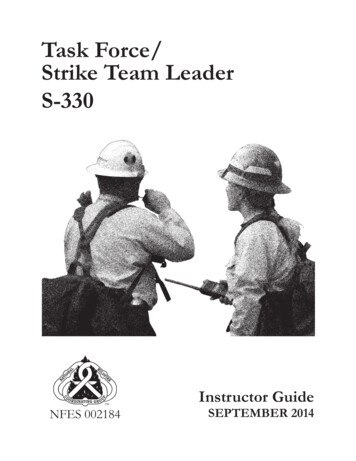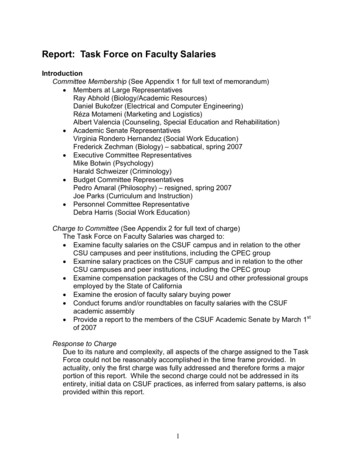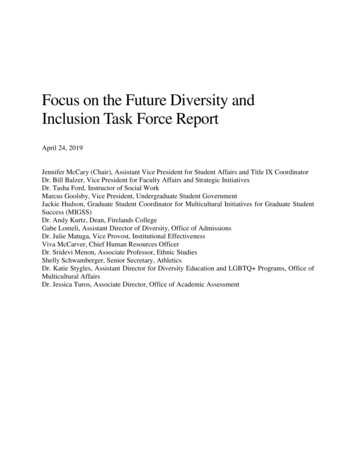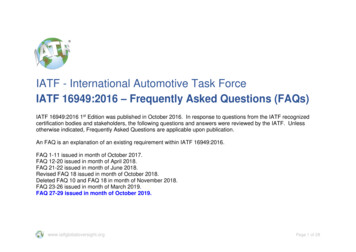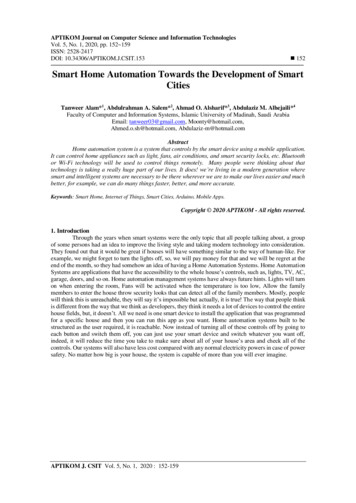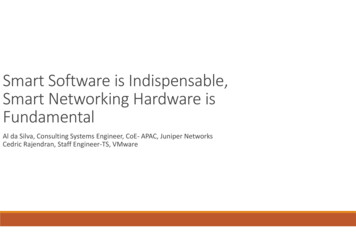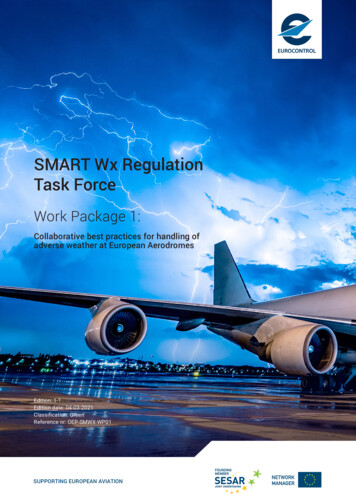
Transcription
SMART Wx RegulationTask ForceWork Package 1:Collaborative best practices for handling ofadverse weather at European AerodromesEdition: 1-1Edition date: 04-03-2021Classification: GreenReference nr: OEP-SMWX-WP01SUPPORTING EUROPEAN AVIATION
EUROCONTROLNetwork Management DirectorateDOCUMENT CONTROLDocument TitleSMART Wx REGULATION TASK FORCE REPORTDocument SubtitleWork Package 1: Collaborative best practices for handling ofadverse weather at European AerodromesDocument ReferenceOEP-SMWX-WP01Edition Number1-1Edition Validity Date04-03-2021ClassificationGreenStatusWorking DraftAuthor(s)Members of the SMART Wx TFContact Person(s)Ms. Teodora POPOVA, NM/APT unit:teodora.popova@eurocontrol.intAPPROVAL TABLEAuthorityDatePrepared by: SMART Wx TFReviewed andSMART Wx TF;endorsedSignature10/01/2021by:10/02/2021Airport Operations lenceApproved by:Network Directors of Operation(NDOP)Edition Number: 1-1Edition Validity Date: 04-03-2021Classification: GreenPage: i
EUROCONTROLNetwork Management DirectorateEDITION HISTORYEdition No.Validity DateAuthor(s)Reason0-111/01/2021Ms. Teodora POPOVAInitial draft0-221/01/2021Y. DE WANDELER,E. LEEMAN, K.VOET,V. CAPPELLAZZO,T.POPOVA, C.PAVLOVR.GRAHAM,Ch. WOODLAND,T.KETTUNEN,F.SALGUERO0-305/02/2021SMART Wx TFmembersSMART Wx TF review1-008/02/2021SMART Wx TFmembersConsolidated version afterSMART Wx TF approval1-13-4/03/2021Airport OperationsTeam (AOT) members,Management OEPConsolidated version at AOT andOEP Management endorsementEdition Number: 1-1Edition Validity Date: 04-03-2021NM Internal reviewClassification: GreenPage: ii
EUROCONTROLNetwork Management DirectorateTABLE OF CONTENTDOCUMENT CONTROL .IAPPROVAL TABLE.IEDITION HISTORY .II1EXECUTIVE SUMMARY .12BACKGROUND .32.12.22.3The SMART Wx TF as part of the Operational Excellence Programme .3SMART Wx TF Objective, Scope and Work Packages .3Task Force membership .43METHODOLOGY .54DOCUMENT STRUCTURE .65THE EVOLVING ROLE OF MET SERVICE PROVIDERS .65.15.25.35.46Integrating MET advice into operations. User oriented MET innovation. .7Operationalised MET forecast. Consistency of MET advice. Common, harmonizedand user oriented MET information. .9Operationalisation of the MET forecast . 9Consistency of MET advice . 10Uncertainty of the Weather forecast. Risk Matrix. 10Risk Matrix . 11Examples of user-tailored MET products. 12Winter Wx Briefing for UK Airports . 12Zurich Airport and MeteoSwiss “O2 briefing sheet”. 12EVOLVING THE ROLE OF THE FLOW MANAGEMENT POSITION (FMP) . 126.16.27ATFCM Operations Manual v24.1 overview related to ATFCM Wx Aerodromeregulations/procedures . 12Suggested areas of improvement to the role of the FMP . 14AIRPORT STAKEHOLDERS’ LOCAL COLLABORATION CELL. 167.17.27.37.4Airport Operations Centre (APOC). Technical enablers- Airport Operations Plan(AOP) and Demand-Capacity Balancing (DCB) tool . 17Common features across Airport Collaborative Best practices for Management ofadverse weather conditions . 19Established Local Collaborative Cell . 19Early start of weather trend monitoring . 20Pre-agreed adverse weather capacity reduction scenarios (playbook). 21Pre-tactical flight cancellation procedures-Sector briefing (Schiphol) and CapacityConstraints Intervention Policy (Heathrow) . 22Motivating the Airlines to participate: a combination of enforcement and incentive23Suggested areas for improvement . 25Edition Number: 1-1Edition Validity Date: 04-03-2021Classification: GreenPage: iii
EUROCONTROL8Network Management DirectorateAIRSPACE USERS’ TAKE ON WX DISRUPTIONS-DELAYS, DIVERSIONS ANDCANCELLATIONS. DECISION SUPPORT TOOLS FOR OPERATIONAL ANDBUSINESS PRIORITISATION . 268.18.28.38.49Short overview of “hub-spoke” transport model comparison to “point-to-point”model. 26Hub-spoke transportation model (national carriers, commercial scheduled airline)26Point-to-point transportation model (low cost carriers) . 27Charter airlines as a part of a Tour Operator Group . 27Long sector flights caught in Wx ATFCM AD regulations at the destination airport.27FMP Finland new ATFM procedure addressing long intra-European flights . 28Weather delays and the Regulation (EC) 261/2004 compensation . 29Certain costs of the obligations imposed by the Regulation (EC) 261/2004 constitutestrong disincentives for compliance . 29Current status of the proposed amendment of the Regulation (EC) 261/2004 . 31Reactionary delays and Airline schedule robustness. 32How the ATM stakeholders can better support the Airspace Users to mitigate theeffects of Regulation (EC) 261/2004. 32Diversions . 32Specific aspect of Charter airlines operations. 32The importance of Playbook scenarios and decision support tools to effectivelymanage disruptive weather situations . 33PROPOSED SMART WX AD REGULATION PROCEDURE . 359.19.2Integration with the Cross-border Procedure. 36The Cross-border Procedure . 36Integrated “AS(Airspace)-AD(Aerodrome) Cross-border” Procedure description . 37Participants . 37Duration . 37Weather Forecast . 38AS-AD Cross-border Procedure Timeline . 3910SUMMARY OF RECOMMENDATIONS . 4211CONCLUSIONS AND PROPOSED WAY FORWARD . 49APPENDIX . 50A.DEFINITIONS . 50B.LONDON HEATHROW AOP AND THE DCB TOOL; “CAPACITY CONSTRAINTSINTERVENTIONSDEMAND VERSUS CAPACITY (DVC) PROTOCOL ANDHADACAB” . 51C.AMSTERDAM SCHIPHOL “COLLABORATIVE DECISION MAKING (CDM)” AND“SECTOR BRIEFING” PROCEDURES. 52D.STOCKHOLM ARLANDA “SNOW PLAN” . 52E.DEMAND VERSUS CAPACITY (DVC) PROTOCOL DESCRIPTION . 52Edition Number: 1-1Edition Validity Date: 04-03-2021Classification: GreenPage: iv
EUROCONTROLNetwork Management DirectorateF.REACTIONARY DELAY BUILD UP-MIRROR CASE STUDY . 52G.STATISTICS ON ATFCM AD WX DELAY . 52H.CROSS-BORDER PROCEDURE OVERVIEW . 52I.BALANCING OF ARRIVAL AND DEPARTURE FLOWS AT AERODROMES WITHPRONOUNCED ARRIVAL AND DEPARTURE PEAKS. HELSINKI CASE STUDY . 52REFERENCES . 53ABBREVIATIONS . 54TABLE OF FIGURESFigure 1: Zurich runway configurations . 7Figure 2: Lightning strike damages aircraft on parking stand . 8Figure 3: LVP Matrix with associated rate values . 9Figure 4: Risk Matrix Cross Border procedure .11Figure 5: Winter Wx Briefing for UK Airports .12Figure 6: Content description of the O2 briefing sheet .12Figure 7: APOC/GC set-up overview .17Figure 8: Relation NM-FMP-APOC/GC .18Figure 9: Heathrow DCB tool, Demand-Capacity Balancer page.19Fig 10 Participants in the AMS CDM Capacity Briefing.20Figure 11: Stockholm Arlanda rate calculation table .21Figure 12: easyJet Flight Tracker App .35Figure 13: Aerodrome vs En-route ATFM delay shares 2003-2020 .35Figure 14: ATFM AD top 20 locations 2003-2020 .35Figure 15: Integrating Aerodromes to the Cross-border procedure .37Figure 16: Geographical coverage ASAD .37Figure 17: Wx Risk colour coding .39TABLE OF TABLESTable 1 - Abbreviations table .54Edition Number: 1-1Edition Validity Date: 04-03-2021Classification: GreenPage: v
EUROCONTROL11.1Network Management DirectorateExecutive SummaryAerodrome adverse weather remains the main reason for ATFM delay at European airports. Whilewe cannot control the weather, the aviation community can improve the operational response toadverse weather effects on aerodrome capacity.The SMART Wx TF, contributing to the Operational Excellence Programme and coordinated by theAirport Operations Team, addresses the collaborative best practices for handling of adverseweather at European Aerodromes. The Task Force composition reflects the contribution of wideplethora of operational stakeholders, such as:1.2 the Airspace Users of the low cost, scheduled airline carriers, and charter airlines; the Airport Operator companies and ACI-Europe; the ANSPs and FMPs, and the national MET Service providers. the SMART Wx TF is co-chaired by the A4E airlines association and the NM/Airports.The SMART Wx TF identified fourteen recommendations grouped in the following areas: Development of tailored-made MET products and services, enabled by the quantumenhancement in MET technologies and user oriented MET innovation. Integration of METadvice in operations. Use of consistent interpretation of the MET forecast, explained inoperational language and referencing specific operational threshold values (see chapter 5); Evolution of the FMPs’ role towards closer working relationship with the airportstakeholders, in particular with the Airport Operations Centre (APOC); where APOC has notbeen established: with TWR ATC and the Airport/Aircraft Duty Manager (AODM); As detailed in chapter 6, the Network Manager has developed an arsenal of ATFMprocedures to counter the effects of weather disruptions at aerodromes for the benefit oflocal stakeholders, the airspace users and the Network. The correct choice of appropriateATFM procedure/regulation and its efficacy depends primarily upon two factors: The FMP’s awareness of the forecasted weather phenomenon and the extent of itseffect on aerodrome capacity: estimated start time, duration, end time, severity andoperational risk assessment. Timely coordination and activation of the ATFM regulation with the NM Pre-Tact or NMTactical teams. Integration of the Aerodrome element to the existing NM Cross-border procedure for enroute convective weather: include aerodrome weather phenomena; extend the procedureto year-round duration and enlarge the coordination to AODM and/or TWR ATC, asappropriate (see chapter 9); All operational stakeholders highlighted the importance of going into the weather event ina controlled manner, with a plan to manage effectively the situation, based on “Playbook”pre-agreed scenarios and ‘what-if’ assessment enabled by suitable software tools. TheTask Force emphasises the benefit of establishing local collaborative cell and commonsituational awareness platform such as the Airport Operations Plan (see chapter 7).Edition Number: 1-1Edition Validity Date: 04-03-2021Classification: GreenPage: 1
EUROCONTROL Network Management DirectorateThe importance of the Airspace Users’ take on weather disruptions: delays, diversions andcancellations. The airlines operate several transport models and react differently to adverseweather. A scheduled commercial airline, or a national carrier operating “hub-spoke”network may have a different take on diversions and pre-tactical flight cancellationscompared to a charter airline that is part of a tour operator.The report briefly summarises the implications of the Regulation EU261/2004 on airlinebusiness decisions and operational response. 1.3The importance of digitalisation of the airlines business: decision support tools foroperational and business prioritisation and digital communication platforms forpassengers (see chapter 8).The benefit for the Aerodromes, ANSPs (including FMPs), the Airspace Users and the NM fromimplementing the SMART Wx Task Force recommendations, is increased predictability ofoperations, reduced cost at local and network level, while making full use of new customeroriented MET products and digital decision support tools.To drive real change in the collaborative management of ATFM regulations for adverse weatherat aerodromes, the AOT and the NDOP/NDTECH are requested to endorse the recommendations,based on the collective operational wisdom of the SMART Wx TF.1.4Within the Airport Operations Team Work Plan and in the context of the Operational ExcellenceProgramme, the SMART Wx Task Force has been working in close coordination with theoperational stakeholders and experts involved in related Work-stream Topics such as those in theWork-stream 03, “Application of ATFCM”, and in particular Topics on “Harmonisation of enroute/TMA weather management” (under ENR/TMA) and “Harmonisation of Airport weathermanagement” (under APT/TWR).1.5In preparation for the next steps, the Airport Operations Team (AOT) representatives are invitedto discuss the findings of the report internally within their respective organisations, involving theMET service providers in the dialogue. The recommendations in relation to local collaboration areintentionally left at the level of principle, because each aerodrome is different and a detailedprocedure may be too prescriptive. If the airport stakeholders implement, tailored to their localcircumstances, the recommendation#10 on establishing a local collaborative cell, this alone willbe a significant step forward, because all best practices shared in the Task Force, are based oncollaboration between the APOC/AODM, ATC TWR, FMP and home based carrier as a minimum.In contrast, a concrete procedure has been proposed for the NM (see chapter 9), because thedevelopment relies upon the existing NM Cross-border procedure, in collaboration with theparticipating ANSPs, MET service providers and eventually APOC SUP/AODM and/or ATC TWRs.Further discussions on practical aspects of this procedure will take place within thecorresponding Network CDM Working Arrangements, such as the Airport Operations Team (AOT)and ATFCM Operations and Development Sub-Group (ODSG).Edition Number: 1-1Edition Validity Date: 04-03-2021Classification: GreenPage: 2
EUROCONTROLNetwork Management Directorate2Background2.1The chapter outlines the endorsement of the SMART Wx TF as part of the OperationalExcellence Programme, the working arrangement with the Airport Operations Team,Objective & Scope and Task Force Membership.2.1 The SMART Wx TF as part of the Operational Excellence Programme2.2The Smart Wx TF addresses the topic “Harmonised procedures for airports with similaroperational environment” of the Work Stream 9 “Harmonised operational requirementssupporting system connectivity, interoperability and implementation” of the OperationalExcellence Programme.2.3The Operational Excellence Programme complements the development andimplementation of the Airspace Re-configuration Programme. The Operational ExcellenceProgramme aims at identifying and implementing best-in-class operational and technicalevolutions to deliver harmonised common operational capabilities among all operationalstakeholders.2.4The Network Directors of Operation (NDOP) and the Network Directors of Technology(NDTECH) manage the Operational Excellence Programme and report to the NetworkManagement Board (NMB). The Joint NDOP/NDTECH Joint Prioritisation workshop inSeptember 2020 included the topic addressed by the SMART Wx TF with high priority to betaken forward by the Airport Operations Team in the context of in the OperationalExcellence Programme Management Plan, which was approved by the NMB at theirmeeting in November 2020.2.5A Champion operational stakeholder and Work stream Leader from NM lead thedevelopment of ea
weather at European Aerodromes. The Task Force composition reflects the contribution of wide plethora of operational stakeholders, such as: the Airspace Users of the low cost, scheduled airline carriers, and charter airlines; the Airport Operator companies
